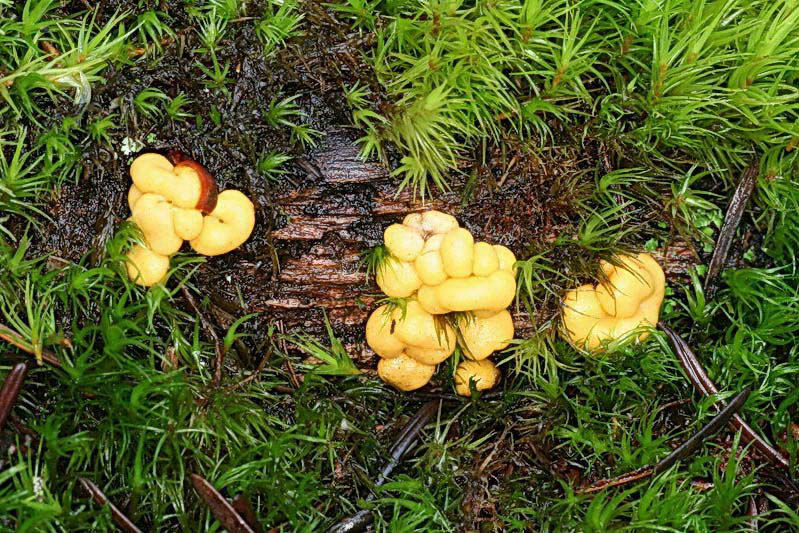
© A and O Ceska
Danny’s DNA Discoveries – Mucoromycota of the PNW
by Danny Miller
|
|
Danny’s DNA Discoveries – Mucoromycota of the PNW
|
|
Introduction
Contrary to popular belief, at least a few fairly large fruitbodies can be made outside of the 'basidio' and 'asco' phyla, most notably in the Mucoromycota. While it's true that there are many other phyla in kingdom fungi, and they mostly produce microscopic "molds", there are some 'large' mushrooms to be found. You can recognize them by giant spores that are usually between 50 and 300 microns instead of the usual 10 microns or so found in 'basidios' and 'ascos'. Many, if not most, of the Mucoromycota produce spores directly from their hyphae, making the entire organism microscopic in size. Those producing fruitbodies large enough to see are the exception. The Endogonomycetes were formerly known as the Zygote fungi. abundant common uncommon rare - colour codes match my Pictorial Key and are my opinions and probably reflect my bias of living in W WA. Rare species may be locally common in certain places at certain times. |
|
Mucoromycota - Glomeromycetes, Endogonomycetes, and
Mucoromycetes
Endogone PNW01 (Endogonomycetes) - Little yellow blobs, about 1-5 mm across, on soil, wood, moss or polypores, that are not jelly like, nor slimy (like young slime molds) nor powdery (like older slime molds). (Slime molds are not covered here because they are not in kingdom fungi). Endogone pisiformis EU is the species reported from here. We have ENA sequences purporting to be this, but our one WA sequence is different. We need EU type area sequences and more local sequences to see if E. pisiformis is also here. Endogone acrogena WA - yellow but more convoluted and less spherical, with matted hyphal threads on the surface. No DNA yet. Modicella malleola CA - small spherical white blobs 2-5 mm across. We have CA sequences and an OR sequence close to them, but need photographed sequenced collections. Modicella PNW01 - small spherical white blobs on elk bones. Youngiomyces stratosus OR (=Endogone stratosa) - smooth to warty layers of folded giant zygospores, whatever that means. Whatever it looks like, it's a few mm wide. I have no DNA from anywhere yet to know what genus this belongs in. I don't even have DNA of the type species of Youngiomyces , Y. carolinensis, to know what that genus is. Endogone PNW01 © Yi-Min Wang, Modicella PNW01 © Sandra Ruffner
Spinellus fusiger EU (Mucoromycetes) - extremely thin stalks growing on the caps of Mycena with tiny round heads. We have some type area sequences, and our one local sequence matches 4/5 of them, meaning it could plausibly be that species, unless the outlier represents the species. unsequenced Spinellus fusiger © Andrew Parker
Most other species in these phyla that you are likely to come across are underground false truffles without much of an outer skin (you can see right through to the spongy interior). If anything, the outer layer is a bunch of cottony threads holding the thing together. Gautieria are similar 'basidio' false truffles with exteriors that can wear away, but they are not uniformly sponge-like inside, they have a false columella (primitive stem) inside. And of course, their spores are way smaller.
Jimgerdemannia and some species of Endogone in the Endogonomycetes are underground false truffles with a skin that easily wears away revealing a uniform spongy interior made of locules that often exude a milky latex when cut fresh. Jimgerdemannia lactiflua UK - mostly spherical, white exterior, pink interior with locules exuding a milky latex. Fruits underground. We have a sequence claiming to be some kind of type sequence, accessioned at OSU in Oregon, but I don't know if it's a local collection. We need local collections. Jimgerdemannia PNW01 - spherical like J. lactiflua, and probably mistaken for it, but the ITS shows it is a distinct species. It too has a whitish exterior and a whitish to cream to pink interior (probably turning more pink as the spores mature). It has been sequenced from OR and CA. Jimgerdemannia flammicorona EU - similar to J. lactiflua and J. PNW01, but more irregularly shaped. We have sequences purporting to be this, but we need type area sequences and local sequences. unsequenced Jimgerdemannia lactiflua © Matt Trappe, J. PNW01 © Heather Dawson (from OR) and Dean Lyons (from CA), unsequenced Jimgerdemannia flammicorona © Matt Trappe
Jimgerdemannia PNW02 - LSU implies this species with yellow latex in a grey interior belongs in this genus, but its too distant in ITS to prove it. Known only from one OR collection. Endogone oregonensis OR - black exterior, grey interior with locules exuding a milky latex. LSU shows that this belongs with Endogone pisiformis, not in Jimgerdemannia. We need ITS sequences. Jimgerdemannia PNW02 © Heather Dawson, unsequenced Endogone oregonensis © Jim and Matt Trappe
Glomus in the Glomeromycetes are similar (usually underground tiny false truffles a few mm across with very large spores, thin skins, and spongy or loculed interiors) that do not always exude a latex when cut. Those that do exude a latex will be hard to differentiate from Endogone and Jimgerdemannia. The following species are reported from the PNW that are big enough to see (usually a few mm across). I have not collected DNA yet (none is available from the PNW) and these remain to be studied. We need collections of all of them. Glomus caledonium UK - Glomus convolutum CA - Glomus fasciculatum PQ - Glomus macrocarpum EU - this might be >1 cm across. Glomus melanosporum OR - Glomus microcarpum EU - Glomus radiatum NH - Glomus vesciuliferum PQ - doesn't form a false truffle, but is a crust on soil about 1 cm across. unsequenced Glomus microcarpum © Jim Trappe |